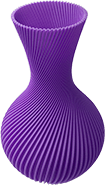Certified Company
Overview: How 3D Printing works?
3D Printing / Additive Manufacturing
At CNP, we choose different 3D printing methods, including fused deposition model (FDM), selective laser sintering (SLS) and stereolithography (SLA), to ensure your prototype has high precision coupled with the best finish.
What Is CNC 3D Printing
3D printing is a technology that builds objects based on digital model files, using bondable materials such as powdered metal or plastic, and printing them layer by layer.
The printed content comes from 3D models or other electronic data, and the printed 3D objects can have any shape and geometric characteristics.
Main 3D Printing Technologies
FDM(Fused Deposition Modeling) FDM technology is to heat and melt the filamentous hot-melt material, and at the same time, under the control of the computer, the three-dimensional nozzle can selectively coat the material on the worktable according to the cross-sectional profile information, and form a layer after rapid cooling section. After the formation of one layer is completed, the machine table is lowered by the height of the one-layer thickness, then form the next layer, work repeatedly until the entire solid shape is formed.
SLS (Selective Laser Sintering) This technology uses powder spreading to spread a layer of powder material on the upper surface of the molded part and heat it to a temperature just below the sintering point of the powder. The control system controls the laser beam to be on the powder layer according to the cross-sectional profile of the layer. After scanning, the temperature of the powder rises to the melting point, sintering and bonding with the molded part below. After one layer is completed, the workbench is lowered by the height of the one-layer thickness, and the spreading roller spreads a layer of uniform and dense powder on it, and sinters the section of the new layer until the entire model is completed.
SLA (Stereo Lithography Apparatus) The liquid tank is filled with liquid photosensitive resin, which will quickly cure under the ultraviolet laser beam emitted by the laser (the laser used in SLA and SLS is different, SLA uses ultraviolet laser, and SLS uses infrared laser). At the beginning of forming, the lifting worktable is below the liquid level, exactly one section thick. The laser beam focused by the lens scans the cross-sectional profile along the liquid surface according to the machine instructions. The resin in the scanning area quickly solidifies to complete the processing of a layer of cross-section and obtain a layer of plastic sheet. Then, the workbench is lowered by the height of the one-layer thickness, and then the other layer is cured. Such layers are superimposed to construct a three-dimensional entity.
Features of 3D printing service
Advantages
The 3D design files are all stored in a virtual library as they are printed using a 3D model as either a CAD or STL file, this means they can be located and printed when needed. Edits to designs can be made at very low costs by editing individual files without wastage of out of date inventory and investing in tools.
Also, parts can be created from tailored materials to provide specific properties such as heat resistance, higher strength or water repellency.
Drawbacks
3D printing capabilities
Tolerances for 3D printing Capabilities
| Feature | Tolerance |
|---|---|
| Our lead times | From 2 |
| Maximum build size | 2100mm*700mm*800mm |
| Dimensional accuracy |
SLA: L<100mm,±0.2mm. L>100mm,±0.2%*L(mm) DLP: L<100mm,±0.1mm. L>100mm,±0.1%*L(mm) SLS: L<100mm,±0.25mm. 100<L<200mm,±0.3mm. 200<L<500mm,±0.5mm. L>500mm,±0.1%*L(mm) MJF: L<100mm,±0.25mm. L>100mm,±0.25%*L(mm) SLM: L<100mm,±0.3mm. L>100mm,±0.3%*L(mm) FDM: L<100mm,±0.2mm. L>100mm,±0.2%*L(mm) |
The Best 3D Printing Material Selection
SLA (Stereolithography) |
FDM (Fused deposition modeling) |
|
| Resin (13 types) | PEEK (1 types) | |
SLS (Selective laser sintering) |
ABS (2 types) | |
| Nylon (2 types) | PLA (1 types) | |
| TPU (1 types) | PC (1 types) | |
DLP (Digital Light Processing) |
PETG (1 types) | |
| Resin (2 types) | ASA (1 types) | |
MJF (Multi Jet Fusion) |
SLM (Selective Laser Melting) |
|
| Nylon (1 types) | Aluminum (1 types) | |
SAF (Selective Absorption Fusion) |
Stainless steel (1 types) | |
| Nylon (1 types) | Titanium (1 types) | |
| Tool steel (1 types) | ||
Custom Sourced Materials
A variety of 3D Printing metal and plastic part options are available for an instant online quote. If you do not see the material stock you are looking for, please choose "Custom" under the material drop-down on your quote page and submit for an expert engineering review once you have specified features, tolerances, inspection needs, and quantities required.







